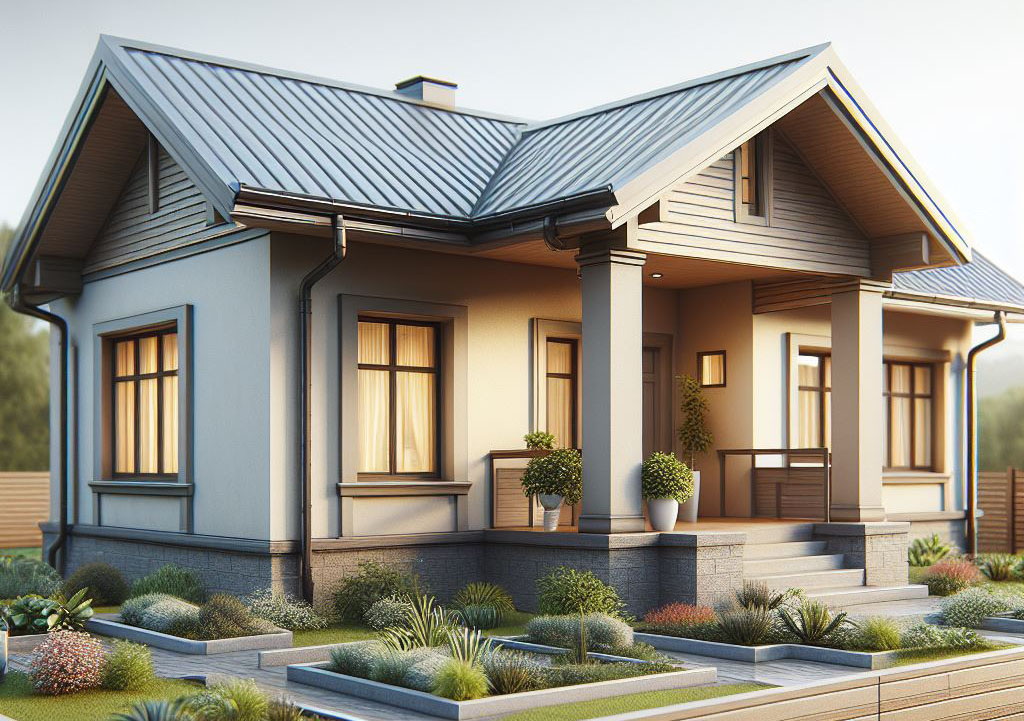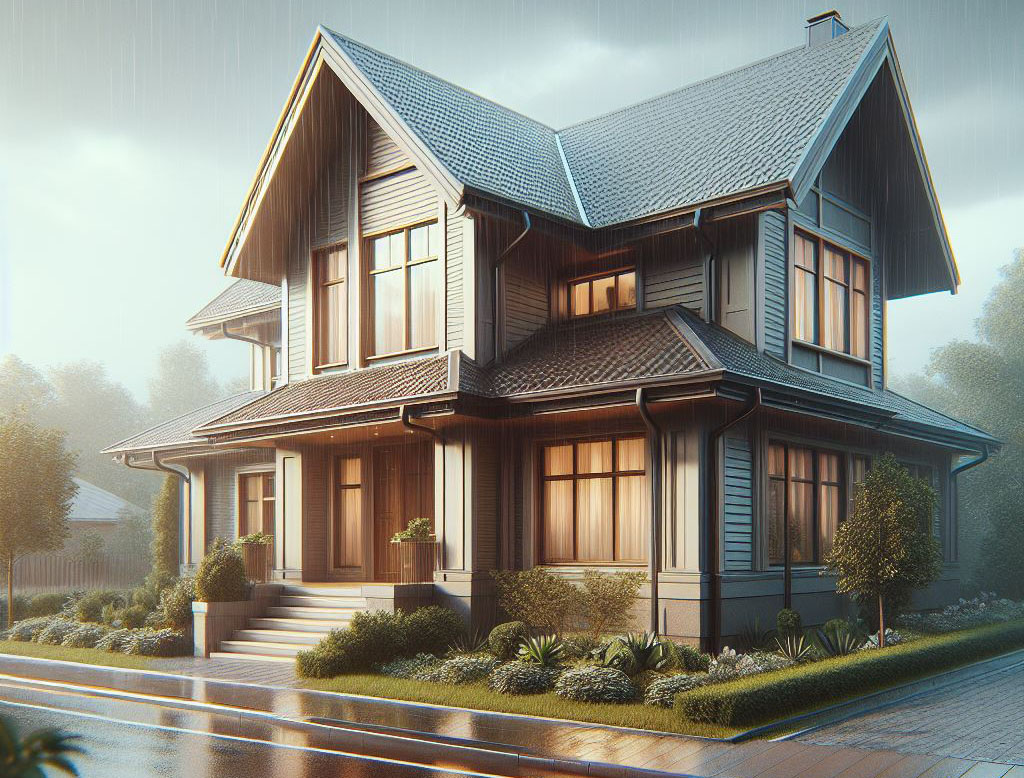Gutters play a pivotal role in the health of your home. They are essential for channeling away rainwater to protect your foundation, prevent soil erosion, and avoid water damage to siding and basements. It’s not just about installing them, it’s about choosing the right type for your home’s needs and maintaining them properly.
This guide is tailored for both the seasoned home handymen and the self-employed construction professionals in the USA. It’s about understanding the nuances of gutters and making informed decisions, whether you’re replacing old gutters or installing them on a new build.

Understanding Gutters: Types and Materials
In the diverse world of gutters, selection is key:
- K-Style Gutters: These are common in modern homes. Resembling crown molding, they offer a decorative look and hold more water than other types, which is beneficial in heavy rainfall areas.
- Half-Round Gutters: With a semicircular design, these gutters are often found on older or historic homes. They offer a traditional appearance but can be more challenging to install and maintain.
- Box Gutters: Integrated into the roof’s structure, these are typically seen in commercial buildings or older residential homes. They are less visible and can handle large volumes of water.
Materials vary widely, each with its own set of characteristics:
- Aluminum: This is a popular choice due to its lightweight nature, resistance to rust, and versatility in color. It’s suitable for most residential applications.
- Copper: Offering a distinctive look that ages to a greenish patina, copper gutters are durable and long-lasting but are on the higher end of the cost spectrum.
- Vinyl: An economical option, vinyl gutters are easy to install and work well in milder climates. However, they may become brittle in extreme cold.
- Steel: Ideal for harsh weather conditions, steel gutters are strong and sturdy but can be prone to rust over time.

Factors to Consider When Selecting Gutters
Several factors come into play when choosing gutters for a home:
- Climate: The local climate is a decisive factor. In regions with heavy snowfall or severe weather, durable materials like steel are advisable, while aluminum or vinyl might suffice in milder climates.
- Aesthetic and Architectural Compatibility: Gutters should complement the style of the home. For instance, half-round gutters may suit traditional homes better, whereas K-style fits contemporary designs.
- Durability and Maintenance: Each material has a different lifespan and maintenance requirement. Copper, for instance, is low-maintenance and long-lasting, whereas aluminum, though durable, might require more regular upkeep.
- Cost: Budget considerations are crucial. Vinyl gutters are cost-effective but less durable, while copper offers longevity but at a higher price point. It’s important to balance initial investment with long-term value.
Installation Insights
Drawing from a deep well of hands-on experience in renovation, I’ve learned that gutter installation is both an art and a science. It’s about precision, understanding the materials, and foreseeing potential challenges.
DIY vs. Professional Installation:
- DIY Approach: For the avid DIYer, gutter installation can be a fulfilling project. It requires precision, the right tools (ladders, levels, drills), and a good understanding of your home’s structure.
- Professional Installation: Sometimes, the complexity of your home’s architecture might make DIY installation more challenging. In such cases, professionals can ensure a seamless and safe installation, especially for multi-story buildings.
Common Installation Mistakes to Avoid:
- Incorrect Slope: An improperly sloped gutter leads to pooling water. Ensure a gradual slope towards the downspout – about half an inch drop for every 10 feet of gutter length.
- Improper Hanger Spacing: Spacing gutter hangers too far apart can cause sagging. Ideal spacing is about every two feet.
- Faulty Seams: For sectional gutters, ensuring the seams are well sealed is crucial to prevent leaks.
Tips for Proper Gutter Alignment and Slope:
- Use a Level: A level is your best friend to ensure the correct slope. Trust the bubble, and you’ll avoid a lot of future problems.
- Accurate Measurements: Measure twice, cut once. This golden rule of carpentry is especially true for gutters, where precision is key to functionality.
Gutter Guards and Accessories
Through years of tinkering and fixing, I’ve seen how the right gutter accessories can drastically improve a gutter system’s efficiency and lifespan.
Overview of Gutter Guards:
- Importance: Gutter guards are a game-changer in reducing maintenance and prolonging gutter life. They keep out leaves and debris, minimizing clogs.
- Varieties: There are several types, including mesh, foam, and surface tension guards. Each serves the same purpose but in different ways and at varying costs.
Different Types of Gutter Accessories:
- Downspouts: Essential for water diversion, ensuring they are correctly sized and positioned is crucial.
- Gutter Hangers: These are the backbone of your gutter system. Quality hangers, properly spaced, are vital for a sturdy, long-lasting installation.
Enhancing Gutter Functionality with Accessories:
- Downspout Extensions: Simple yet effective, these extensions are crucial for directing water away from the foundation.
- Splash Blocks: These prevent soil erosion under downspouts and protect your foundation.
- Heat Tape: In colder climates, heat tape is invaluable for preventing ice dams.
The world of home renovation is filled with small decisions that have big impacts. Choosing and installing the right gutters and accessories is one of those decisions. It’s not just about directing rainwater away, it’s about protecting the integrity and longevity of your home. With these insights, you can approach gutter installation and maintenance with confidence and precision.
Maintenance and Upkeep
In my extensive journey through the world of renovation and construction, I’ve come to appreciate the critical role of gutters in preserving the integrity of a home. Here are some practical insights based on years of hands-on experience.
Routine Maintenance Tips for Gutters:
- Regular Cleaning: Clear your gutters at least twice a year, in spring and autumn, to prevent blockages.
- Inspection: Regularly check for signs of wear such as cracks or rust, and ensure that gutters are securely attached to the fascia.
- Alignment Check: Ensure that gutters are properly aligned for efficient water flow towards the downspouts.
Signs of Gutter Wear and Damage:
- Sagging Sections: Often a sign of failing hangers or brackets.
- Peeling Paint or Rust: Indications of water damage or age-related wear.
- Water Stains: Suggest that water is not being effectively channeled away.
Recommendations for Cleaning and Repair:
- Methodical Cleaning: Use a sturdy ladder, protective gloves, and carefully remove debris. Finish by flushing the gutters with a hose.
- Repair Tactics: For minor damages, use gutter sealant for small holes and replace damaged hangers or screws.
- Seeking Professional Assistance: For extensive damage, such as severe rust or structural issues, professional repair or replacement is advisable.
Innovations in Gutter Technology
Gutter technology has evolved significantly, incorporating new materials and designs to enhance functionality.
Recent Advancements in Gutter Design and Materials:
- Seamless Gutters: These are gaining popularity for their leak-minimizing design.
- Advanced Materials: Newer materials, such as improved aluminum alloys, offer enhanced durability and longevity.
Eco-friendly and Sustainable Gutter Options:
- Recycled Material Gutters: Options include gutters made from recycled aluminum, which are both environmentally responsible and durable.
- Rainwater Harvesting Systems: These systems are a practical way to conserve water and can be integrated with your gutter system.
Smart Gutters and Technology Integration:
- Heated Gutter Systems: A solution for preventing ice dams in colder climates.
- Innovative Sensors: Some gutter systems now include sensors to alert homeowners to blockages or excessive water flow, helping to prevent potential damage.
FAQ Section
Aluminum gutters typically last about 20 years, while copper ones can last up to 50 years. Vinyl gutters have a lifespan of around 20 years, but this can vary based on climate and maintenance.
The size should be based on the dimensions of your roof and local rainfall patterns. Larger roofs or those in areas with heavy precipitation may require wider or additional gutters.
While gutter installation can be a DIY project for simpler systems, complex configurations or homes with multiple stories may benefit from professional installation for safety and functionality.
Cleaning and inspecting your gutters at least twice a year is recommended. However, if your home is under heavy foliage or in an area with frequent storms, more frequent maintenance may be needed.
Yes, there are options like gutters made from recycled materials, as well as systems that facilitate rainwater collection for sustainable water use.
